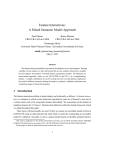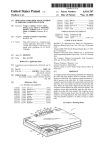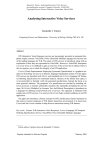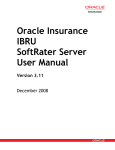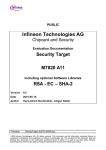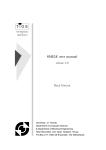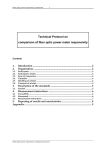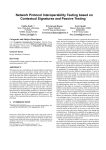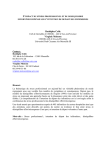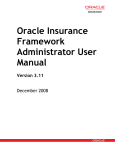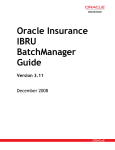Download Feature Interactions: A Mixed Semantic Model Approach
Transcript
Feature Interactions:
A Mixed Semantic Model Approach
Paul Gibson
CRIN URA 262 du CNRS
Bruno Mermet
CRIN URA 262 du CNRS
Dominique Méry
Université Henri Poincaré-Nancy 1 & Institut Universitaire de France
email: (gibson/mery/mermet)@loria.fr
May 2, 1997
Abstract
The feature interaction problem is prominent in telephone service development. Through
a number of case studies, we have discovered that no one semantic framework is suitable
for the synthesis and analysis of formal feature requirements models. We illustrate our
mixed-model approach, where we use OO LOTOS, B and TLA+ in a complementary
fashion. A simple combination of call forwarding and call screening features emphasises
the need for different semantics during the analysis, synthesis, validation, refinement and
verification stages of formal development.
1 Introduction
The feature interaction problem is stated simply, and informally, as follows: A feature interaction is a situation in which system behaviour (specified as some set of features1 ) does not as
a whole satisfy each of its component features individually. We concentrate on the domain of
telephone features [8, 5]. Figure 1 illustrates this definition within the formal framework which
we adopt throughout this paper.
Three types of formal models are used. Firstly, we require an executable model (written in
LOTOS [19] using an object-based style [16]) which is useful for constructing an executable
model for validation. Secondly, we have a logical model (based on the B[1] method) which is
This work is supported by the Institut Universitaire de France, by the HCM Scientific Network MEDICIS
(CHRX-CT92-0054) and by the contract n 96 1B CNET-FRANCE-TELECOM & CRIN-CNRS-URA262
1
In this paper we make no distinction between a feature and a service.
1
Feature 1
Feature1 and Feature2
Dynamic Validation (Animation)
Formal
Model F1
Informal
Requirements
F1 + F2
List of Properties Desired
F1
List of properties desired
F11,...F1n
Static Validation
Verification
F11,F12,...,F13
and
Feature
Combination
F21,F22,...,F23
F2
Feature 2
Verification
Dynamic Validation (Animation)
Informal
Formal
Model F2
Requirements
Interaction Definition:
F1 satisfies F11 ^F12^...^F1n
F2 satisfies F21^F22^...^F2m
not ( (F1+F2) satisfies (F11^...^F1n^F21^...^F2m))
List of properties desired
F21,...F2m
Static Validation
Verification
Figure 1: Feature Interaction: A formalisation
used to verify the state invariant properties of our system (statically). Finally, we use TLA [23]
to provide semantics for a static analysis of liveness and fairness properties. No one model can
treat each of these aspects, yet each of these aspects of the conceptualisation are necessary in
the formal development of features.
2 Feature Interaction: What’s so difficult?
Features are observable behaviour and are therefore a requirements specification problem [31].
Most feature interaction problems can be (and should be) resolved at the requirements capture
stage of development. If there are no problems in the requirements specification then problems
during the design and implementation will arise only through errors in the refinement process.
Certainly the feature interaction problem is more prone to the introduction of such errors because of the highly concurrent and distributed nature of the underlying implementation domain,
but this is for consideration after each individual feature’s requirements have been modelled and
validated; otherwise it will not be easy to identify the source of the interaction. Features are
requirements modules and the units of incrementation as systems evolve. A telecom system is
a set of features. A feature interaction occurs in a system whose complete behaviour does not
satisfy the separate specifications of all its features. Having features as the incremental units of
development is the source of our complexity:
Complexity explosion: Potential feature interactions increase exponentially with the number of features in the system.
Chaotic Information Structure In Sequential Development Strategies: The arbitrary
2
sequential ordering of feature development is what drives the internal structure of the resulting system. As each new feature is added, the feature must include details of how it
is to interact with all the features already in the system. Consequently, to understand the
behaviour of one feature, it is necessary to examine the specification of all the features in
the system. All conceptual integrity is lost since the distribution of knowledge is chaotic.
Assumption Problem: Already developed features often rely on assumptions which are
no longer true when later features are conceived. Consequently, features may rely on contradictory assumptions.
Independent Development: Traditional approaches require a new feature developer to
consider how the feature operates with all others already on the system. Consequently, we
cannot concurrently develop new features: since how the new features work together will
not be considered by either of the two independent feature developers. We want to have
an incremental approach in which the developers do not need to know anything about the
other features in the system. In our approach, it is the system designers who must resolve
the integration problems: integration methods arise from an analysis of the features to be
integrated. Formal requirements of individual features are required for the integration process to be verified.
Interface Problem: User controls on traditional phones are very limited and hence the
input and output signals become polymorphic. This is a major problem in requirements
specifications as it can lead to the introduction of ambiguities in systems of features. Formal requirements models make explicit the mapping between abstract and concrete actions
and our systems can be automatically verified to ensure an absence of ambiguity that could
lead to interactions.
Invalid Plain Old Telephone Service (POTS) Assumptions: Phone systems have changed
dramatically over the past ten years. Many people (including feature developers) are not
aware of the underlying complexity in the concrete system and, as a way of simplifying
the problem, often make incorrect assumptions based on their knowledge of the plain old
telephone service.
The feature interaction problem is difficult: having formal requirements models makes it
manageable. A formal model of requirements is unambiguous — there is only one correct way
to interpret the behaviour being defined. Although the model must still be mapped onto the real
world (i.e. validated by the customer), this mapping is in essence more rigorous than in informal
approaches. Building a formal model requires a better understanding of the problem domain
and a better understanding of how the problem domain is viewed by the customer. A formal
model can explicitly model nondeterminism, when choice of behaviour is specified. Another
advantage of a mathematical approach is that high levels of expressibility allow the definition
of what rather than how. In our formal approach, interactions occur only when requirements
of multiple features are contradictory. The complexity of understanding the problem is thus
contained within a definition of contradiction in our semantic framework.
3
3 OO LOTOS
In the thesis of Gibson [17], which forms the basis of our development method, there is an
object oriented semantics based upon a constructive, easy to understand, state transition system
model. The abstract data type (ADT) part of LOTOS, see [6, 21, 29], is used to implement
the requirements models which are defined using this semantics. Then, full LOTOS (LOTOS
with the ADT and process algebra parts) is used to model the requirements in a more concrete
framework, during design. LOTOS is advantageous during feature development because:
Its natural division into ADT part (based on ACT ONE [13]) and process algebra part
(similar to CSP [20] and CCS [26]) suits our need for semantic continuity from analysis
to design.
LOTOS is a wide spectrum language, which is suitable for specifying systems at various
levels of abstraction. Consequently, it can be used at both ends of the design process.
There is wide support, often in the form of tools, for the static analysis and dynamic
execution of LOTOS specifications: for example, see [29, 19, 3, 27].
The object oriented methodology, with all its associated advantages, is supported by the
OO LOTOS work. This makes building and validating models much more compositional.
OO LOTOS does not offer us an easy means of verifying design steps as model refinements.
Furthermore, the LOTOS semantics do not include the notion of liveness and fairness.
4 TLA
TLA+ [25] is a specification language based on set theory and the temporal logic of actions,
TLA [24]. It is a state-based methodology such as VDM [22], Z [28] or B [1]. However,
unlike these other methods, fairness or eventuality properties on traces can be expressed and
verified. A system is modelled as a set of behaviours and a behaviour is built from the set
of states according to the actions that lead from one state to another state. The TLA logic
has been integrated with a specification language [25] based on set theory and is structured by
modules. Actions are perfomed by the system and an idle action corresponds
to stuttering. A behaviour is a mathematical object that characterizes the real system and it is
a way to interpret TLA formulae. The set of behaviours for S is denoted
. A system
"!
S satisfies a formula , if any behaviour of S satisfies :
, if ,
where is a TLA formula.
TLA formula are based on the use of primed and unprimed variables: a primed variable
designates the state of the unprimed variable in the next state. For instance, #$
#&%('
4
will mean that x is incremented by one. Moreover, Lamport combines this new kind of basic
assertion with temporal operators and the stuttering principle. A TLA formula has one of the
following forms (where: is a predicate2, is a state function, is an action, # is a variable,
and and are TLA formulae):
Satisfied by a behaviour iff
is true for the initial state.
Satisfied by a behaviour iff every step satisfies ( is always true.) Satisfied by a behaviour iff #
!
(Weak fairness of ) Satisfied by a behaviour iff enabled, or infinitely many $ steps occur.
is true for all suffixes of the behaviour.
Satisfied by a behaviour iff there are some values that can be assigned to # to produce a
behaviour satisfying .
or leaves unchanged.
(Strong fairness of ) Satisfied by a behaviour iff often, or infinitely many $ steps occur.
( is eventually true) Defined to be (Whenever is true, $ $ is infinitely often not
is only enabled finitely
.
will eventually become true) Defined to be
.
Using TLA has two advantages. Firstly, the semantics of eventuality and fairness are easy
to exploit. Secondly, refinement is proved by logical implication. Unfortunately, TLA does not
provide a modular approach to model construction. Furthermore, TLA is not easily validated
by the customer.
5 The B Method
The B method is a formal specification method developed by Abrial [1]. It is based on set
theory and first order predicate logic. B specifications are structured as machines. A machine
encapsulates variables and operations on these variables. Variables can have any type of the
Zermelo Set Theory. Each machine has an invariant, that describes a set of states in which
its variables must remain. The method allows an automatic generation of proof obligations:
theorems that must be proved to guarantee that the machine has the following properties :
its initialisation establishes the invariant ;
each operation preserves the invariant.
2
Having Boolean predicates means that we include Boolean operators with their usual meanings.
5
Moreover, the B Method allow a data refinement process : an abtract machine can be refined
by another. The method gives rules to prove the correctness of the refinement. Once again, the
proof obligations can be generated automatically. The refinement process allows a progressive
transition from an abstract high-level specification to a concrete low-level specification. If the
last refinement is completly deterministic, then an automatic translation into a programming
language can be done. The fact that many steps of a formal development in B can be done
automatically makes this method well suited to an industrial usage. Two tools are currently
available:
the Atelier B, developed by Steria[12] ;
the BToolkit, developed by B-Core[2]
Both tools are based on a theorem prover that solves between 60% and 80% of the proof obligations generated, the rest have to be analysed interactively.(These percentages are taken from
a small subset of case studies. Currently, we are extending the set of data and hope to publish
some more meaningful results. The complete set of data is available on request.)
The strength of the B method is in the specification and verification of invariant properties,
and the preservation of these properties during refinment. Although there are some compositional operators in B, these are not as powerful as those associated with our OO conceptualisation as they are primarily syntactic (like macro expansions). There is an animator built into
the B tools but, again, the validation process would benefit from more powerful composition
operators. Finally, unlike TLA, B does not provide semantics for fairness and liveness.
6 The Plain Old Telephone Service (POTS)
As an aid to comprehension we limit our domain of study to interactions which deal only with
the telephone users’ points of view. We also restrict our level of abstraction: problems due to
sharing of resources, information hiding, interface realisation, etc . . . are design issues and are
not examined here. The key to understanding features is the language(s) we employ for communication, verification and validation. Three different, though complementary, views of features
play a role in the process of requirements capture. Before we examine the specific interaction
of the call screening and call forwarding features, we summarise the different semantic views
and use them to model the POTS requirements of a single phone3.
3
This specification is much simpler than the real case, but we abstract away from a number of details in order to
simplify our reasoning.
6
States and Actions: A dynamic (object LOTOS) view
Labelled state transition systems are often used to provide executable models during the analysis and requirements stages of software development [10, 11]. In particular, such models play
a role in many of the object oriented analysis and design methods [4, 9]. However, a major
problem with state models is that it can be difficult to provide a good decomposition of large,
complex systems when the underlying state and state transitions are not fully understood. The
object oriented4 paradigm provides a natural solution to this problem. By equating the notion
of class with the state transition system model, and allowing the state of one class to be defined
as a composition of states of other classes, we provide a means of specifying state transition
models in a constructive fashion. Further, such an approach provides a more constructive means
of testing actual behaviour against requirements. This is explained in more detail in [17] where
OO LOTOS is used to provide a state based view of objects as processes.
The equations of a class specify how all its member objects respond to all valid service
requests. In fact, they correspond to labelled state transitions. The equations map a state before
the transition to a state after transition (and may be labelled by a value to be returned to the
service requester). An object’s state can be structured or unstructured. An unstructured state
is represented by a literal value. A structured state is represented by a set of component objects. Composition is primarily a relationship between objects. It can, however, be extended
to classes: when all class members are represented by the same structure then the class can,
without ambiguity, be said to be composed from the classes which parameterise the structure.
The dynamic behaviour is modelled by the state transition system, corresponding to our OO
LOTOS specification, in figure 2.
This state based object view forms the basis on which we build our feature animations and
permit behaviour validation in a compositional manner. However, they are not good for formal reasoning about feature requirements. For this we need to consider specification of state
invariants and fairness properties.
Defining Invariants: A static (B) view
Invariants are needed to specify abstract properties of a system which must always be true. The
object oriented approach permits the definition of three sorts of invariant:
Typing: By stating that all objects are defined to be members of some class we are in
fact specifying an invariant. This invariant is verified automatically by the O-LSTS tools.
Service requests: Typing also permits us to state that objects in our system will only
ever be asked to perform services that are part of their interfaces. This invariant is also
4
In fact, in this paper we do not consider such issues such as subclassing, inheritance and polymorphism; thus
the view is really object based.
7
CLASS Phone USING UID,signal,hook
INTERNAL : otherChangehook, dialIn(UID), otherBusy, otherFree,give-up
STRUCTURE : hook, signal
otherChangehook
lift
Off,Talking
Off,Ringing
On,Ringing
otherChangehook
drop
otherBusy
drop
dialIn(UID)
otherFree
Off,Busy
drop
otherChangehook
Off,Silent
On, Silent
drop
dial(UID)
lift
Off, Ready
give-up
drop
lift
dial(UID)
drop
listen:signal
receiver:hook
Figure 2: A single POTS phone user model
verified automatically by the O-LSTS tools.
State Component Dependencies: In a structured class we may wish to specify some
property that depends on the state of two or more of the components, and which is always
true. This cannot be statically verified using the O-LSTS semantics (of OO LOTOS) but
can be treated through a dynamic analysis (model check). Unfortunately, such a model
check cannot be guaranteed when we have large (possibly infinite) numbers of states in
our systems. For this reason we need to adopt a more proof theoretic framework (such as
the B tool).
By translating our state invariant requirements into another proof theoretic framework 5 we
have been able to statically verify our state component invariants. These invariants are often
the key to feature interactions: when features are components and their invariants are not guaranteed by the containing system then we have an interaction.
A state invariant which defines a relation between the hook component and the signal
component will include the following requirement: (signal = talking) => (hook
= off). In the simple finite telephone system, this is directly verifiable by checking that
it is true in all the states. In the network of many different telephones we use the invariant
to specify relations between pairs of phones. For example, a simple POTS state invariant requirement is that only an even number of phones can be talking at the
same time. This is proved by showing that it is true in the initial state (where all phones
are off and ready). Then we show that all possible state transitions maintain the required
5
In fact, we have successfully performed the translation to B and PVS.
8
property (if it is true before the action occurs then it is true after the action occurs). This property cannot be checked through an exhaustive search of a system of an unbounded number of
phones. It can be checked by proving that all transitions are closed with respect to the invariant.
Temporal Logics: A fairness (TLA) view
In TLA, a system is modeled as a set of traces over a set of states. The specifier may decide
to ignore traces that do not satisfy a scheduling policy, such as strong or weak fairness, and
temporal operators, such as (Always) or (Eventually), are combined to express these assumptions over the set of traces. Such fairness is important in feature specification and cannot
be easily expressed using OO LOTOS or B. The key is the need for different abstractions for
nondeterminism in our requirements models.
Without a temporal logic, nondeterminism in the features can be specified only at one level
of abstraction: namely that of an internal choice of events. This can lead to many problems in
development. For example, consider the specification of a shared database. This database must
handle multiple, parallel requests from clients. The order in which these requests are processed
is required to be nondeterministic. This is easily specified in our OO semantic framework.
However, the requirements are now refined to state that every request must be eventually served
(this is a fairness requirement which we cannot express in our semantic framework). The only
way this can be done is to over-specify the requirement by defining how this fairness is to be
achieved (for example, by explicitly queueing the requests). This is bad because we are enforcing implementation decisions at the requirements level. With TLA we can express fairness
requirements without having to say how these requirements are to be met.
Nondeterminism in the telephone is specified through internal events. These correspond
to actions which are not available to the phone user but which perform state transitions. The
simple phone example illustrates the need for fairness (where we specify that something good
eventually happens rather than that something bad never happens). Consider a telephone which
has just dialled a number and is off hook and silent. The user does not wish to remain in
this state indefinitely but can only drop the phone if they wish to instigate a state change.
By specifying fairness on the give-up action we guarantee that this state transition must
eventually happen if the phone stays in the off-silent state (for whatever reason).
A TLA specification of a more complicated version of POTS is given below. It illustrates
the use of fairness to guarantee the eventuality of internal events.
module POTS-SPECIFICATION
This module defines the specification of the Basic Phone System POTS and it uses modules
CALL-DEFINITIONS, POTS-ACTIONS-OFF-HOOK, POTS-ACTIONS-ON-HOOK, POTS-ACTIONSCOMMUNICATION, POTS-ACTIONS-DIAL
9
IMPORT
!""#
$
%
DECLARATIONS
&('*)+
VARIABLE
bps is a flexible variable containing the current state of the basic system.
, &('*)+
VARIABLE
ubps is a flexible variable containing the current state of the user and system
DEFINITIONS
The flexible variables are used within the invariant, permitting the strengthening of action refinements.
- .-/$0235
1 4 , (& '*) 34 , )768)97&('*)::
The initialisation of the system.
<;>=@?A=@BC = )7BD?A=@E;F3H
1 G # )768) ;>I JB)7=@K L>ED;>6 M)7?A6N 4 , &('*):
#
GPO ,.Q 7) 68) <ID6;>?A= RSK<BD?@=@ED;T+ , &('*)U ,WV 3YX
G4 , &('*) 3Z4 , )768)97&('*)::
POTS_Next defines the translation relation of the global telephone system.
6<[D?\3 1
] , )768 Q #)768 <ID6;>?A= RSK<BD?A= ED;T+!]^'_L>ED;>6 Q L>ED;>67)+
]=@;>=@? , )768 BD;>I '_L>ED;>67) )76?<97ID67)7? , )768 BD;>I '_L>ED;>67) )76? Q
#)768) <ID6;>?A= RSK<B?A=@ED;0`L>ED;>67):+
S UBSET 4
]K<BC@C Q BC@C+
a !
4 , )7689 , &('*):
a !
4 , )7689b'_L>ED;>6D9 , &('*):
a /%!% 4 , )7689('_L>ED;>6D9 , &('*):
a % 4 , )7689b'_L>ED;>6D9 , &('*):
a $ 4 =@;>=@? , )768 BD;>I '_L>ED;>67) )76?<9<ID67)7? , )768 BD;>I '_L>ED;>67) )76?<9 , &('*):
a !""# 4 =@;>=@? , )768 BD;>I '_L>ED;>67) )76?<9<ID67)7? , )768 BD;>I '_L>ED;>67) )76?<9<K<BC@C$9 , &('*):
a !""# 0c. 4 =@;>=@? , )768 BD;>I '_L>ED;>67) )76?<97ID67)7? , )768 BD;>I '_L>ED;>67) )76?<9<K<BC@C$9 , &('*):
a !""# J0#!d 4 =@;>=@? , )768 BD;>I '_L>ED;>67) )76?<97ID67)7? , )768 BD;>I '_L>ED;>67) )76?<97K<BC@C$9 , &('*):
a 4 , )768 BD;>I '_L>ED;>6 )76?<97K<BC@C$9 , &('*):
a J 4 K<BC@C$9 , &('*):
BD=@8<;>67)<)e3 1
10
O , 7) 68 Q #)768 <ID6;>?A= RSK<BD?A= ED;T+
O '_L>ED;>6 Q L>ED;>67)+
O =@;>=@? , )768 BD;>I '_L>ED;>67) )76?<97ID67)7? , )768 BD;>I '_L>ED;>67) )76? Q S UBSET 4 #)768) <ID6;>?A= RSK<B?A=@ED;0`L>ED;>67):+
O K<BC@C Q BC@C+
G WF !
4 , )7689 , &('*):
G WF !
4 , )7689b'_L>ED;>6D9 , &('*):
G WF /%!% 4 , )7689('_L>ED;>6D9 , &('*):
G WF % 4 , )7689b'_L>ED;>6D9 , &('*):
G WF $ 4 =@;>=@? , )768 BD;>I '_L>ED;>67) )76?<9<ID67)7? , )768 BD;>I '_L>ED;>67) )76?<9 , &('*):
G WF !""# 4 =@;>=@? , )768 BD;>I '_L>ED;>67) )76?<9<ID67)7? , )768 BD;>I '_L>ED;>67) )76?<9<K<BC@C$9 , &('*):
G WF !""# 0c. 4 =@;>=@? , )768 BD;>I '_L>ED;>67) )76?<97ID67)7? , )768 BD;>I '_L>ED;>67) )76?<97K<BC@C$9 , &('*):
G WF !""# J0#!d 4 =@;>=@? , )768 BD;>I '_L>ED;>67) )76?<97ID67)7? , )768 BD;>I '_L>ED;>67) )76?<97K<BC@C$9 , &('*):
G WF 4 , )768 BD;>I '_L>ED;>6 )76?<97K<BC@C$9 , &('*):
G SF J 4 K<BC@C$9 , &('*):
^'_6<K= RSK<BD?A=@ED; 3H
1 G <;>=@?A=@BC = )7BD?A=@E;
V
G U - .-/$0 G 6<[D? G - .-/$0
G BD=@8<;>67)<)
7 Feature Interaction: Call Screening and Call Forward
This feature combination is interesting because it illustrates that precision in requirements really
does help to avoid feature interactions. In particular, it shows the importance of the validation
process in the development of formal models. Furthermore, it illustrates why we need a mixed
semantic approach.
Call Screening (CS)
Informally, call screening is easy to understand. With CS I can program my phone to ignore
certain incoming calls so that my phone does not ring. The calls to be ignored are identified by
a list of numbers. Every incoming call identfication is then checked against this list.
Call Forwarding (CF)
Call forwarding is also easy to understand informally. If I activate call forwarding (CF) then all
my incoming calls are forwarded to another number.
The potential interaction
The question that needs to be addressed is whether there is an interaction between these two
features. Informally, let us consider a simple scenario. Firstly, what happens if:
11
A screens calls from B
C forwards calls to A
B calls C
The problem is that A does not want to receive a call from B. However, C is visiting B and
redirects calls accordingly. Now B wishes to talk to C, phones C and this results in a call to A.
A therefore receives a call from B. This contradicts A’s requirements for call screening. If we
specify that B’s call to C does not get forwarded to A then we contradict C’s requirements for
call forwarding. This is clearly an interaction . . . or is it? We need to analyse the problem in
our formal framework.
OO LOTOS
The OO LOTOS specification lets us easily construct an executable model for the testing of
our particular scenario. However, which model should we build: the one which contradicts A’s
requirements or the one which leaves C unsatisified? Without an explicit statement of what is
required, we do not know which model to validate as correct.
B
The figure, below, shows the formal composition of abstract machines in B. The composition is
based on the sharing of variables between machines. This makes the analysis easy to perform
but the composition technique very limited. We treat each component machine as if it was
the environment of the other. Then we check that all operations respect the invariants of each
individual machine.
The application of such a composition technique is very useful when analysing the abstract
requirements of feature compositions. We can immediately detect contradictory requirements
because invariants are unprovable.
When composing call forwarding with call screening we used the B tools as follows:
We proved the correctness of the POTS machine wrt the POTS invariant.
We proved the correctness of the CF machine wrt the CF invariant.
We proved the correctness of the CS machine wrt the CS invariant.
We proved the correctness of combining the POTS machine with the CS machine, producing a new machine M3.
We proved the correctness of combining M3 with CF.
12
MACHINE M1
MACHINE M2
Operation Set O1
INVARIANT I1
Operation Set O2
State S1
INVARIANT I2
State S2
O1 union O2
I1 ^ I2
S1,S2
MACHINE M1 + M2 = M3
FORMAL VERIFICATION
1: All operations in O1 respect the invariant I2
2: All operations in O2 respect the invariant I1
1: I2(S2) => I2(op1(S2)), forall op1 in O1
3: Initial States are correct
3: I1(s1,s2) ^ I2(s1,s2), forall inital s1,s2
2: I1(S1) => I1(op2(S1)), forall op2 in O2
Figure 3: Machine Composition in B
At each of these stages, we had to change our specifications in response to problems with the
invariant proofs. For example, we found problems in POTS when telephone users unsubscribed
when in the middle of a service. In other words, using the B tools helped us to identify where
our specifications were incomplete. Furthermore, in the case of the CF-CS composition we
realised that there were contradictions in the requirements only when the specifications of each
individual feature were not well expressed. There is in fact no interaction with the two services
if we make no assumptions about who lifts a phone (A or C in our scenario are both capable of
lifting the phone) when it is ringing.
The B specification led us to generate a set of requirements as a conjunction of invariant
properties (which are not contradictory). We now change the LOTOS specification to remove
the unnecessary assumption which we discovered using the proof tools. Then, using the OO
LOTOS, we validated this behaviour through animation. (During the design process, we implemented the distinction between the two users (A and C) by having two different types of
ringing at the phone, one for normal calls to A, and one for calls forwarded to C.)
TLA
The TLA is needed for one simple reason: we cannot guarantee that the services will eventually be carried out. The use of internal actions introduces the need for fairness requirements.
13
Without TLA, how can we express the fact that if a call is being forwarded it will eventually
reach the new destination? We use the TLA to express such properties; although the integration
of the TLA semantics with B and OO LOTOS is not complete. We are working on the notion
of a fair object which will always guarantee that it will eventually be able to service a particular
request.
We identify five different types of client eventuality requirements:
Immediately and Obliged
A client may require that a service request be serviced immediately. If it cannot be
carried out then the client cannot function properly.
Eventually and Obliged
A client may require that a service is carried out eventually, i.e. in a finite period of time.
If it is not carried out eventually then the client cannot function properly.
Immediately Conditional
A client may require a service immediately but if it cannot be done without delay then it
must be informed so that it can attempt to do something else.
Eventually Conditional
The service is required eventually but if it cannot be guaranteed in a finite period of time
then the client must be informed so that something else can be done.
Unconditional
The client wants the service but places no eventuality requirements on when the service
must be performed.
In a fair object specification we must define explicitly the eventuality requirements that
clients must place on servers. This covers two aspects:
Explicit Customer Requirements
This is the case when the client being considered is the complete system and the environment of the system is the customer. Eventuality requirements specified at this level
correspond to explicit fairness properties.
Internal Client Requirements
This is the case when the internal components of the system place eventuality requirements on each other. The correct functioning of the system as seen by the customer
is dependent on some hidden internal eventuality requirements being met. These requirements are generated during the system development as we move from abstract to
concrete. In an unstructured system no such requirements will exist. However, as we
structure the system we will introduce such requirements between the components we
introduce.
14
It is the use of TLA semantics which make it possible to work with these eventuality concepts.
8 The Feature Case Studies: A Review
We cannot possibly review all the feature compositions which we have developed using our
mixed model approach. Rather, we review the main lessons that we learned from our case studies:
Use Strong Typing
The advantages of typing in all forms of development are well known. Types are not needed
in correct systems but they do help to create correct systems. A simple telephone example is
that of the concept of a telephone number. Clearly, telephone numbers are polymorphic within
a concrete subtyping hierarchy. Without types, it is difficult to handle the different natures of
telephone numbers at the requirements stage.
Use Types as Behaviours or Roles
Here we impose the object oriented principle of classification. The class is used as the fundamental unit of behaviour (and as the means of typing these units). Thus, every feature is a class
which plays a specific role. The class hierarchy provides a behavioural benchmark for categorising features. Already some work has been done towards creating a benchmark for feature
interactions [7] and we believe an object oriented strategy would complement this research.
Use Invariants
Invariants are used to define relationships between components of a system that must be true
during the lifetime of the system. They are a well understood, formal means of specifying
requirements in a compositional manner. Every non trivial component (of a (sub)system), i.e.
one with its own components, has an associated invariant and there is one invariant between all
components (of a (sub)system).
Avoid ambiguity in naming of actions
The practice of polymorphic actions arises from the minimilistic interface provided by most
telephones. For example, a flash hook action can signal different things to different features. If
these features are requested at the same time then the meaning of a flash hook may be ambiguous. Whenever possible try to maintain a clear distinction between abstract actions/signals in
the requirements model and concrete actions/signals in the implementation model.
Features should be explicit not implicit
Typically, features appear in formal specifications only as implicit, derivable properties of the
total system. We can verify that a system complies to the requirements of a feature but there is
no compositional means of removing the feature and examining it as a single identity. Given a
logical landscape as our semantic basis would permit such a compositional view since the properties required of a feature are exactly its specification. However, in such a logical approach,
15
the actual development of features is much more complicated. We believe that we should have
an explicit compositional approach in the same spirit as the logical method, whilst avoiding the
synthesis and analysis problems that arise from features that are specified logically.
Arbitration and interaction resolution
We have not examined the question of interaction resolution in this paper, since we wanted to
concentrate on the question of interaction avoidance arising from formal feature requirements
models. However, interactions do occur when feature requirements are contradictory. Clearly,
when two features have contradictory requirements then one (or both) of the feature specifications will have to change if the two features are to be combined in a meaningful way. Arbitration
is one means of changing the requirements of some feature(s) to remove the contradiction. This
arbitration can be done both statically, in the specification, or dynamically, during execution.
Arbitration can be done independently of the order in which services are implemented. The
process of arbitration is one which we are currently examining.
Choosing Modelling Languages
The advantage of a logical approach is self evident: the combination of features is just logical
conjunction and the absence of interaction is automatic, provided the result is not false. The
disadvantage of such an approach is the difficulty in constructing new features and analysing
their dynamic behaviour. The principal problem is that of communicating with the clients in
such a mathematical model. Contrastingly, more operational (state based) approaches are more
powerful with respect to synthesis and analysis. However, it is then much more difficult to
say what it means for two features to be contradictory (i.e. have requirements that cannot be
met at the same time). The main source of feature interaction problems seems to be exceptions. Using invariants helps to transfer the analysis of exceptions away from the dynamic and
towards a purely static approach. An object oriented approach gives us abstraction and generalisation within a compositional user friendly framework. A combination of a number of
semantic frameworks seems to be the only option for all our modelling needs. The problem of
feature interaction is so general, with complex, diverse issues, that we cannot expect a single
semantic model approach to be satisfactory.
Operational Requirements are necessary
Concurrent (independent) development of features requires separation of specification from
implementation. However, for implementors (designers) to fully understand requirements we
expect to be able to animate our specifications. This is also a necessary part of validation. Thus
we require operational semantics [30] for our feature specifications (as well as our more abstract logical requirements for testing compatibility).
The incremental development problem: minimise impact of change
In traditional problem domains (and using state-of-the-art development methods) when new
functionality is added to a system it is possible to do this by connecting it to only a small subset
of the system components. (We will not for now attempt to define the different types of connec16
tion.) Additions that are localised (with fewer connections) are easier to make than those which
are spread about the system. The addition of a feature is inherently a non-local problem (in
the current telephone architectures) because it necessitates connection with most of the other
components (the other features) in the system. Hence, each addition has global impact. We are
searching for an architecture which supports local incrementation techniques.
Restrictive Assumption Approach
Restrict the assumptions that a feature developer can make about the behaviour of its environment (other features in the system included). Since new features will be added later we cannot
place any assumptions on them. However, in some cases assumptions must be made. These
should be specified as invariant properties that are amenable to static analysis. Our goal is
to simplify this analysis by formalising a minimum assumption set that does not restrict our
functionality but does eliminate interactions.
9 Conclusions
We have shown the need for different semantics for:
Structuring a model — where we apply object oriented conceptualisation.
Validating a model — where we use the OO LOTOS
Verifying invariant properties — where we use B
Verifying liveness and fairness properties — where we use TLA.
Performing verifiable refinements — where we use TLA
Currently, we are attempting to integrate the different semantics into one coherent model [15,
14, 18].
A mixed-semantics approach is particularly important in telephone feature development.
However, we believe our approach is also applicable in all other problem domains where functionality is distributed over concurrent resources.
References
[1] J.-R. Abrial. The B-Book. Cambridge University Press, 1996.
[2] B-core. B-Toolkit User’s Manual, Release 3.2. Technical report, B-core, 1996.
[3] T. Bolognesi and M. Caneve. SQUIGGLES: A tool for the analysis of LOTOS specifications.
In K.J.T. Turner, editor, The 2nd International Conference on Formal Description Techniques
(FORTE 89), 1989.
17
[4] G. Booch. Object oriented design with applications. Benjamin Cummings, 1991.
[5] L. G. Bouma and H. Velthuijsen, editors. Feature Interactions In Telecommunications. IOS Press,
1994.
[6] E. Brinksma and Scollo G. Formal notions of implementation and conformance in lotos. Mem:
INT-86-13, University of Twente, NL, December 1986.
[7] E. J. Cameron, N. D. Griffeth, Y. Lin, M. E. Nilson, and W. K. Schnure. A feature interaction
benchmark for in and beyond. In Feature Interactions In Telecommunications, 1994.
[8] K. E. Cheng and T. Ohta, editors. Feature Interactions In Telecommunications III. IOS Press,
1995.
[9] P. Coad and E. Yourdon. Object oriented analysis. Prentice-Hall (Yourdon Press), 1990.
[10] L. Constantine. Beyond the madness of methods: System structure methods and converging design.
In Software Development 1989. Miller-Freeman, 1989.
[11] Geoff Cutts. Structured system analysis and design method. Blackwell Scientific Publishers, 1991.
[12] Digilog. Atelier B, Guide de l’utilisateur v2.0. Technical report, Digilog, 1995.
[13] H. Ehrig and Mahr B. Fundamentals of Algebraic Specification I. Springer-Verlag, Berlin, 1985.
EATCS Monographs on Theoretical Computer Science (6).
[14] J.-P. Gibson and D. Méry. A Unifying Model for Multi-Semantic Software Development. Rapport
Interne CRIN-96-R-110, Linz (Austria), July 1996.
[15] J.-P. Gibson and D. Méry. A Unifying Model for Specification and Design. Rapport Interne CRIN96-R-110, Linz (Austria), July 1996.
[16] J. Paul Gibson. Formal object based design in LOTOS. Tr-113, University of Stirling, Computing
Science Department, Stirling, Scotland, 1994.
[17] J.Paul Gibson. Formal Object Oriented Development of Software Systems Using LOTOS. Tech.
report csm-114, Stirling University, August 1993.
[18] J.Paul Gibson and D. Mery. Telephone feature verification: Translating SDL to TLA+. Accepted
for SDL97, Evry, France (to be announced), 1997.
[19] R. Guillemot, M. Haj-Hussein, and L. Logroppo. Executing large LOTOS specifications. In Proceedings of Prototyping, Specification, Testing and Verification VIII. North-Holland, 1991.
[20] C.A.R Hoare. Communicating Sequential Processes. Prentice-Hall International, 1985.
[21] ISO. LOTOS — a formal description technique based on the temporal ordering of observed behaviour. Technical report, International Organisation for Standardisation IS 8807, 1988.
[22] C. B. Jones and R. C. Shaw. Case Studies in Systematic Software Development. Prentice-Hall
International Series in Computer Science. Prentice-Hall, 1990. ISBN0-13-116088-5.
[23] L. Lamport. A temporal logic of actions. Technical Report 57, DEC Palo Alto, april 1990.
18
[24] L. Lamport. A temporal logic of actions. ACM Transactions on Programming Languages and
Systems, 16(3):872–923, May 1994.
[25] L. Lamport. TLA . Technical report, December, 5th july 1995.
[26] R. Milner. A Calculus of Communicating Systems. Springer-Verlag, 1980.
[27] K. Ohmaki, K. Futatsugi, and K. Takahashi. A basic LOTOS simulator in OBJ. Computer Language Section, Computer Science Division, Electrotechnical Laboratory, 1-1-4 Umezono, Japan,
Draft Report, 1990.
[28] J. M. Spivey. Understanding Z : a specification language and its formal semantics. Cambridge
University Press, 1987.
[29] van Eijk, Vissers, and Diaz. The Formal Description Technique LOTOS. North-Holland, Amsterdam, 1989.
[30] Pamela Zave. The operational versus the conventional approach to software development. Comm.
ACM, 27:104–118, 1984.
[31] Pamela Zave. Feature interactions and formal specifications in telecommunications. IEEE Computer Magazine, pages 18–23, August 1993.
19



















